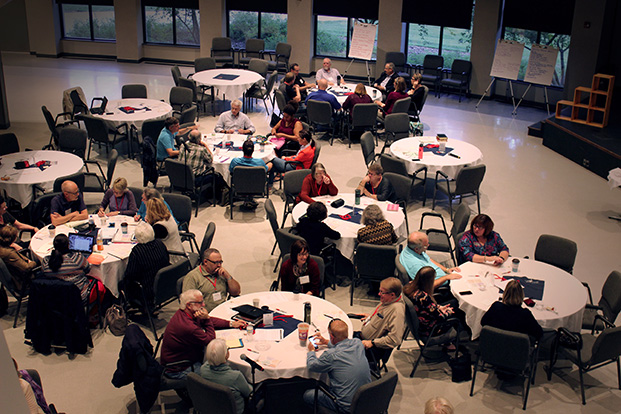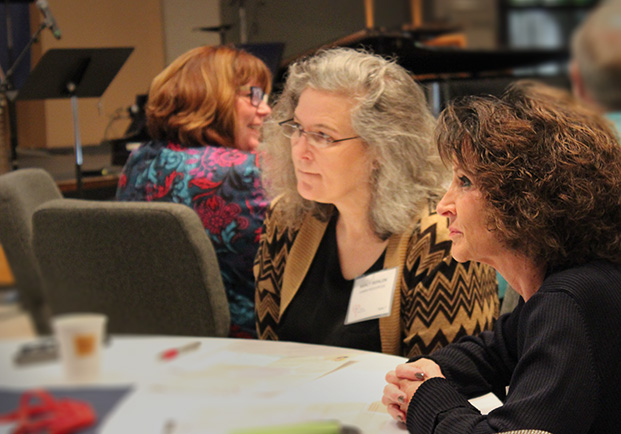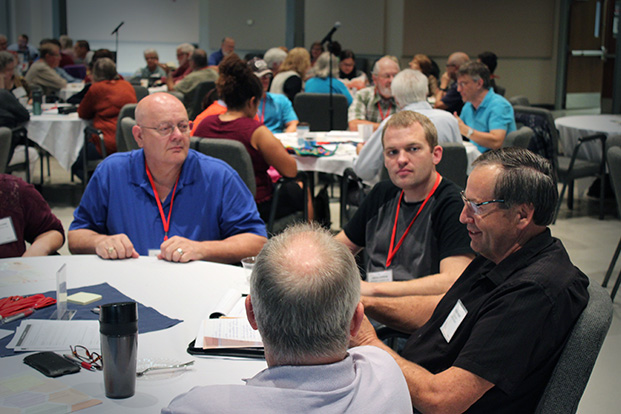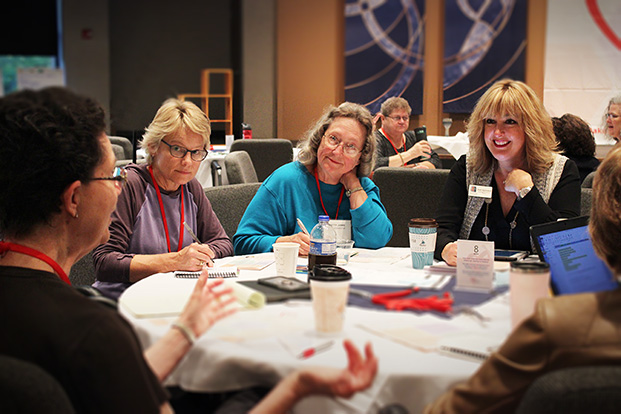
Leaders gather to learn and cast vision
 MITCHELL, S.D.—Over 65 leaders from across the Dakotas Conference gathered in the Sherman Center of Dakota Wesleyan University (DWU) to learn, discuss and cast a vision forward for the Dakotas Conference. Photo: Round tables in the Sherman Center provided room for the discussions.
MITCHELL, S.D.—Over 65 leaders from across the Dakotas Conference gathered in the Sherman Center of Dakota Wesleyan University (DWU) to learn, discuss and cast a vision forward for the Dakotas Conference. Photo: Round tables in the Sherman Center provided room for the discussions.
“All in, unleashing God’s gifts,” was the theme of the two-day event in Mitchell, S.D. Dr. Amy Novak, president of DWU, led a time learning about organizational leadership. Novak discussed nine traits of thriving organizations.
“I call each and everyone here to commit to being all in,” said Bishop Bruce R. Ough,  resident bishop. Photo: DWU President Dr. Amy Novak makes her presentation on Friday, Sept. 30 at All In.
resident bishop. Photo: DWU President Dr. Amy Novak makes her presentation on Friday, Sept. 30 at All In.
“All in, what does it mean and what does it take?” asked Dr. Amy Novak, DWU president. Novak shared insights on leadership and thriving organizations at the 2016 fall leadership event. Thriving organizations have nine behaviors that they practice on a routine basis:
Courageous and collaborative leadership—Organizations that are highly effective have leadership teams that are: functional and effective, make room for failure, have high expectations, operate with a balance between leadership and inclusivity, make timely decisions and own the mission and vision of the organization.
Compelling spiritual and organizational vision—Novak shared an understanding of mission, values and vision. “Mission is what you do. Values are why you do what you do. Vision is where you are going,” said Novak. Thriving organizations have made intentional efforts to plan, collaborate for vision to be owned by all members of the organization.
Culture of planning and innovation— Thriving organizations create bold, living plans, paying close attention to connection and communication within the entire community.
Organizational self-esteem—Thriving organizations are proud of the work they do. Performance is routinely evaluated for effective contribution to the vision. The achievement, growth and engagement of the community is consistently, strategically affirmed. Photo: Participants shared and listened in small groups on Saturday.
Institutional story—Thriving organizations know who they serve. The organization communicates the right message at the right time to draw the audience they serve closer.
Community engagement—Thriving institutions know their community, meet them where they are and take them to a place of their highest potential. The organization is an active participant in strengthening the local community, responding to injustice, and fostering a Christian ethos.
Strategic finance—Thriving organizations recognize that executing the mission and vision is dependent on the financial health of the institution. The finances allow the organization to think innovatively about how we serve and invest in our community.
Environment—Thriving institutions focus on virtual and physical spaces that foster spiritual growth. Buildings and grounds are assets and not liabilities. A master plan guides the future growth of the institution.
Habit of reflection and commitment to prayer—"Prayer is important to who we are and guides our work here at Dakota Wesleyan,” said Novak. “We would not be here if the circuit riders of 1883 did not choose this place.” Spirituality is critical to the success of the mission and vision. Spirituality needs to be fed through intentional focus and creating space and habits of reflection.
 “The Journey Toward Vitality is our living, bold plan for the Dakotas Conference,” said Bishop Bruce R. Ough, resident bishop. “I ask each of you as leaders to live into our vision—for every congregation to become a vital expression of the scriptural imperatives to grow in love of God and neighbor, reach new people, and heal a broken world.” Photo: Participants engaged in the discussions.
“The Journey Toward Vitality is our living, bold plan for the Dakotas Conference,” said Bishop Bruce R. Ough, resident bishop. “I ask each of you as leaders to live into our vision—for every congregation to become a vital expression of the scriptural imperatives to grow in love of God and neighbor, reach new people, and heal a broken world.” Photo: Participants engaged in the discussions.
Participants spent time in discussion and reflection around key questions: How does what you have learned inform our Journey to Vitality? How does what we have learned inform the work of conference leadership? How can we take the best of what has been learned back to the local ministry setting?
Groups orally shared their thoughts around the key questions. “We each need to share the vision and live out the vision of the Conference in all we do.” “Being intentional about planning and having the pathways in front of us as we work is important.” “Sharing our story as a team and conference is critical for us and for those who are not here.”
Those present spent time together in worship, fellowship, learning and discussion.  The Dakotas Conference Common Table coordinated the event. “We are here to learn and grow with each other,” said Sheila Dailie, president of the Common Table. Photo: Small groups dug deeper into their visions for their tables' topics.
The Dakotas Conference Common Table coordinated the event. “We are here to learn and grow with each other,” said Sheila Dailie, president of the Common Table. Photo: Small groups dug deeper into their visions for their tables' topics.
Click here for more information about the Journey Toward Vitality.
Click here for a copy of President Novak’s Power Point presentation.